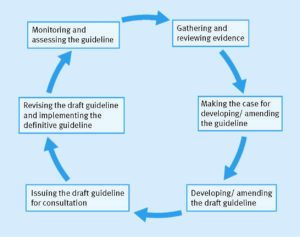How the Council works
Providing judges and magistrates with sentencing guidelines is the primary duty of the Council. We take a number of steps in the process of developing our guidelines from first draft, through the consultation stages and on to developing the definitive version that will be used by the judiciary.
Step 1 – Priorities
The Council identifies priorities for the development of guidelines. This decision could be made on the basis of concerns about an existing guideline, identifying offence types that lack a guideline or because we have been required by statute to look at a particular area.
Step 2 – Research
We undertake research, carry out policy and legal investigations and consider outcomes of current sentencing practice for different demographic groups. The Council meets to talk about the guideline and agree the approach that should be taken, and an initial draft guideline is created.
Step 3 – Approach
Council members discuss the draft guideline, refine the approach and agree on the broad structure and detail that will form the basis for consultation.
Step 4 – Consultation
We consult on our draft guideline, seeking the views of our statutory consultees, criminal justice professionals and the wider public, usually over a 12-week period. We also produce a draft resource assessment and statistical bulletin to support the consultation.
Step 5 – Responses
The Council carefully considers the responses to the consultation and develops a definitive version of the guideline. We also produce a consultation response paper and resource assessment.
Step 6 – Publication
We publish the definitive guideline, which will come into force on the next of four dates: 1 January, 1 April, 1 July or 1 October. Where necessary, we also support training for sentencers in using the new guideline.
Step 7 – Monitoring
Once a guideline is in force, the Council monitors its use and effect, including assessing its impact on different demographic groups, using data collection and other research.
The continuous process of guideline development

Our approach
The Council is outward-facing, responsive and consultative and draws on expertise from relevant fields wherever necessary to inform our work. We aim to foster close working relationships with judicial, government and non-government bodies while retaining the Council’s independence. We engage with the public on sentencing, provide information and encourage debate. We focus on three areas of work; sentencing guidelines, research and analysis and improving public confidence.
Public consultation
The Council routinely consults members of the public about our work. We publish drafts of each of our guidelines for consultation, and almost always amend draft guidelines in the light of consultation responses, sometimes quite fundamentally. We also seek responses from criminal justice professionals, subject experts and others with an interest in criminal justice or the topic of the guideline. The Government will also normally respond to our consultations. We promote all our consultations and publish them on the website.
The Council takes consultation very seriously and our draft guidelines are almost always revised as a result of the responses we receive.
As well as consulting as we develop and revise guidelines, Council also conducts research with the public and victims to ensure that guidelines fully reflect the harm caused to victims by offending.
Research and analysis
The Act places a number of obligations on the Council with regard to monitoring and data analysis. To fulfil these statutory obligations the Council is responsible for its own independent statistical analysis, impact assessments and research to support its functions. There is more information on our research and resources pages.
Public confidence
The Council works to improve public confidence in sentencing. We do this by increasing the quantity and quality of information and engagement available to the public on sentencing. In all of our work on confidence we look to understand and respond to the needs of members of the public who are directly affected by sentencing, particularly as victims and witnesses.